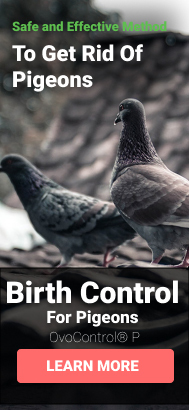Rail Facilities Bird Control: Proven and Effective Solutions
Written by Erick Wolf
Rail facilities bird control is a significant concern due to various factors like health hazards, safety risks, and potential equipment damage. The complexity of these environments necessitates innovative, humane, and effective solutions such as those offered by OvoControl.
In this article, we’ll take a closer look at bird control for rail facilities, including the importance and some of the proven strategies available on the market today.
Importance of Bird Control in Rail Facilities
Rail facilities’ bird control is crucial because these areas often prove attractive to bird populations due to their offer of shelter, food, and potential nesting areas. However, large bird populations in these environments can lead to various issues.
Health Hazards
Bird droppings are a major health concern in rail facilities, as they carry pathogens harmful to humans. Without effective bird control measures, employees and passengers alike could be exposed to these health risks.
Electrical Hazards
Electrical hazards are another significant concern. Birds and their nests can cause short circuits, power outages, and even fire hazards. Additionally, their droppings can contaminate electrical equipment, leading to more frequent and costly maintenance cycles.
Slip and Fall Hazards
Rail platforms and walkways can become treacherously slippery due to bird droppings. Without adequate bird control, these areas present an increased risk of slips and falls for passengers and staff.
Equipment Damage and Contamination
Birds can cause extensive damage to rail facilities, including bridges, platforms, and canopies. Their droppings can lead to structural degradation and increased maintenance costs.
Operational Disruptions
Birds can trigger alarms, activate safety systems, or interfere with signaling equipment. These disruptions can cause delays and disrupt the smooth operations of rail services.
Noise Disturbances
Birds can generate noise that can be disruptive to both passengers and workers in a rail facility. Proper bird control measures can help ensure a quieter, more comfortable environment.
Potential Fines and Penalties
Adherence to regulations and standards regarding bird control measures in rail facilities is crucial. Failure to do so could lead to fines and penalties, making bird control an essential aspect of facility management.
Proven Strategies for Rail Facilities Bird Control
Several proven strategies can help control bird populations in rail facilities. The effectiveness of these methods can vary, and some solutions may be better suited to specific environments or species.
Bird Birth Control
Birth control methods, like those offered by OvoControl, present a humane and effective solution. We'll explore this in more detail in a later section.
Bird Netting
Bird netting serves as a physical barrier, obstructing birds' access to potential nesting or roosting areas. It can effectively deter birds from settling in areas like bridges, canopies, and underpasses within rail facilities.
However, it's worth noting that bird netting requires significant maintenance and may be unsightly. Moreover, birds can become entangled in netting, leading to injuries and potentially negative public perception.
Bird Deterrents
Bird deterrents are a range of devices and techniques engineered to make an environment less hospitable to birds. Successful case studies include the implementation of bird deterrents at Roosevelt Island station in New York and St Pancras station in the United Kingdom.
Yet, birds may acclimate to some deterrents over time, reducing their effectiveness. Additionally, some deterrents, such as noise-makers, can disturb passengers and staff and may not be suitable for all environments.
Bird Spikes and Wires
Bird spikes and wires are physical deterrents that prevent birds from landing on surfaces. Frequently, they are installed on ledges, signs, and other structures within rail facilities to deter birds from nesting or roosting.
Similar to bird netting, these devices may impact aesthetics and risk injuring birds. They also require ongoing maintenance to maintain their effectiveness and safety.
Bird Gel
Bird gel is a sticky substance applied on surfaces where birds may land. This substance makes the surface uncomfortable, deterring birds from nesting in these areas.
While bird gel can be effective in the short term, frequent reapplication may be necessary, increasing maintenance costs. Also, prolonged use can lead to surface discoloration or damage and, in certain cases, could harm birds that come into contact with it.
Why Use OvoControl for Rail Facilities Bird Control?
In stark contrast to many of the traditional bird control methods mentioned above, OvoControl offers a unique, humane, and sustainable solution for bird control in rail facilities. OvoControl uses a specially formulated bait acting as a birth control for birds. This method prevents eggs from hatching, effectively controlling bird populations over time.
This approach reduces the risks associated with health hazards, slip and fall hazards, and operational disruptions caused by birds in rail facilities. It also eliminates the negative aesthetic impact and potential harm to birds associated with methods like netting, spikes, wires, and gel.
In utilizing OvoControl's innovative solution, rail facilities can maintain ecological balance while ensuring a safer, cleaner environment for both employees and passengers.
Final Thoughts
Managing bird populations with rail facilities bird control requires a balanced approach, combining traditional methods with innovative solutions like OvoControl. By prioritizing bird control for rail facilities, business owners can maintain operational efficiency, ensure staff and passengers' health and safety, and protect their infrastructure's integrity.





